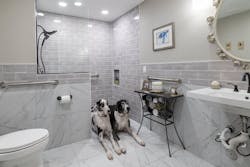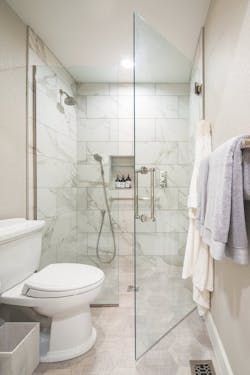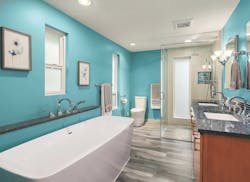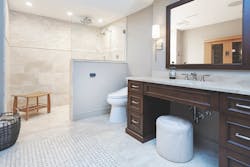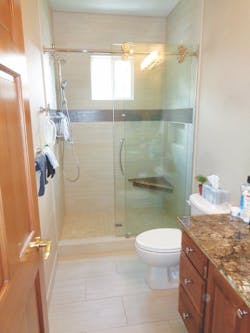Did you know that 80% of falls in a home happen in the bathroom?
What’s worse is that 33% of those require hospital admission. And we’re not just talking about seniors here. People of any age slip and fall in bathrooms.
Think about it: you’re wet and stepping over a tall tub or into a shower while standing on one foot with hard, sharp countertops nearby. Or maybe you’re soapy and/or have shampoo in your eyes and lose your balance. Or (another maybe) you’re showering after having a drink or two and the room is spinning (bad idea). Everyone and their mother would benefit from a few universal design features.
Why so much concern about falls? Falls in general account for 95% of all hip fractures, and 25% of those patients will die within six months. Falls, especially hip fractures, have long-term negative effects on the person affected.
So how do we prevent falls in bathrooms? By removing hazards: Zero-step (curbless) showers, nonslip floor tile, multiple grab bars (and can we avoid the stigma by renaming them “assist bars” please?), better lighting, rounded corners, and built-in benches are all features that help keep the user safe.
And the time to install some of these features is before the homeowner needs them. May I suggest they become a new standard practice?
This marble-clad bath remodel by Jeremy Parcels, owner of Parcels Design Studio in the Denver area, has a seamless level entry into the shower, a handsome grab bar on the back wall, and both a fixed head and a handheld. Shower controls are just inside the door as you enter the shower so you can stay dry while the water temperature adjusts.
The clients were ambulatory, so wheelchair access was not an issue here, and the shower is small enough that they chose not to install a bench, but will buy a freestanding teak one when they need it.
Subtle features, like an accent strip around eye level in a shower, provide a reference horizon to the user. Think of taking a shower this morning with soap in your eyes, so your eyes are closed. Wouldn’t a horizontal grab bar to rest your hand on help you orient yourself? If you shave your legs in the shower and are balanced on one foot to do so, wouldn’t that same grab bar make it safer?
This bath from Adam Gibson, an architectural designer serving greater Indianapolis, features vanities at different heights for each user, a curbless shower, a vertical shower bar that doubles as a grab bar, and a strong horizon line of tile. Not shown is a window at eye level on the back wall for interest.
The best way to anchor assist bars is with blocking in the walls where you think they may be placed. Do this during framing, before the mechanical trades start, to avoid conflict. I install blocking for towel bars as well and use the same assist bars as towel bars. If someone slips in a bath, they will grab anything within reach to stop their fall. We photograph the blocking rough-ins and note the height and width on the photos for the clients’ future reference should they not install assist bars right away.
Spectrum of Ability
Let’s talk about the spectrum of ability. The percentage of Americans who get around via wheelchairs or scooters is 0.5%. By contrast, the percentage of Americans with compromised vision is 26%. Deaf or severely hearing impaired individuals are 20%, and 16% of all American households contain some member dealing with a neurological disorder.
A full 75% of all disabilities are “invisible,” meaning they are not immediately evident to the viewer, and the truth is that some have multiple disabilities. Not so simple, is it? Our remodeling solutions need to be tailored to the client, and not only to the client today, but to that same person living 10 years from today.
Here’s an aqua-colored bath remodel by Paula Kennedy, owner of Timeless Kitchen Design in Seattle. The project has a beautiful curbless shower, grab bars (including over the toilet paper holder), and a soaking tub. The tub doesn’t have grab bars, but it does have a clever ledge that not only allows the use of an inexpensive deck mount tub filler but provides a solid surface to brace oneself getting in and out.
Assist bars may be a hard sell to younger clients. Last year I did a second-story addition and partial main floor remodel for a 40-year-old triathlete, who ridiculed my suggestion for grab bars but did allow us to put in blocking. What that triathlete found out not long afterward is that one twisted ankle on a training run meant he’d be calling the contractor to come put in that grab bar. Fortunately, even if we had not put in blocking, there are clever hardware pieces that can be drilled into hollow shower walls and provide rated load capacity (250 pounds) for grab bars. And grab bars today come in all shapes and finishes. A company called HealthCraft invented a category of “stealth” grab bars with their Invisia Collection. Other manufacturers have followed suit.
I was honored to be included on a National Kitchen and Bath Association task force that worked for two years during the pandemic to completely rewrite the Kitchen & Bath Design Guidelines to reflect current practice and thinking, with much discussion around accessibility of all kinds. The guidelines grew from 77 pages to 270 pages in the process. One of the things I am most proud of is our differentiation of levels of abilities; not just ambulatory versus wheelchair users, but five different gradations:
• Standing
• Ambulatory
• Standing with assistance
• Seated
• Short-term disability
• Long-term disability
We are all somewhere on the spectrum of ability. As I write this, I am two weeks away from hip replacement surgery and look forward to not having to use a cane to assist my with my mobility and safety. One never can predict what the future holds, but we can design for it long before it becomes necessary. Statistically, 11% of 25 to 44 year olds can be classified as disabled in some way.
That percentage climbs to 70% for 70 to 74 year olds, and keeps climbing with age. Although ADA doesn’t apply to single-family homes, we have a moral responsibility, a sacred trust, to make the homes we remodel suitable for our clients now and in the future. A 10 or even 20-year look ahead is appropriate. This need is a growing business opportunity for remodelers.
There is a small portion of the population (less than 1% actually) that gets around in wheelchairs. Planning for this takes a little more thought and square footage. This lovely bath is by Katy Lynn Retzbach, founder of Designs By Katy Lynn in Newtown Square, Penn. The project was created for a client with ALS, a neurological condition. Notice there are no grab bars because the client doesn’t have use of his hands and bathes with assistance. The shower also has voice control which he can operate.
One of the pro bono remodels I did in 2021 was for a client who became quadriplegic after a car accident. She is on a ventilator and needs an assistant to help her bathe. We borrowed 30 inches from an adjacent closet to make the shower large enough for her shower chair and assistant. The grab bars are not for the client, but for the assistant, to prevent her from slipping.
The entire bathroom floor has been waterproofed against inevitable splashes (there is a shower curtain on there now). The exhaust fan has a heater, as clients with spinal cord injuries get cold easily.
Almost every senior when asked says they wish to remain in their home for the rest of their lives. What will your homeowner’s life look like in 25 years?
Back when I started designing remodels, I had a question on my 14-page architectural questionnaire that read, “Do you have any physical or other condition that limits your mobility?” I don’t think I had one answer to that one, until I changed it to “Do you have parents, friends, or grandparents who may be visiting who have a mobility impairment?” The answers to that came fast and furious.
Of course, we are all in denial about our diminishing capabilities. I remember one older client who didn’t indicate any special need, yet had a constant, obvious tremor in her hands. She asked for the laundry and an office downstairs, so I designed it with a gentle stair with handrails on both sides and made it straight with an outlet on the side, so that a lift chair could be installed easily in the future.
Even if the client isn’t asking for it, go the extra mile and put in those wider doorways, lever hardware, rocker switches, and grab bar blocking in showers as standard practice in any remodel or addition you do. Someone may need it some day, but everyone will benefit from it in the meantime. That’s the benefit of universal design.
People without use of their legs are defined as paraplegics, and usually have well-developed upper body strength to help them transfer from a chair to a bench or in this case, a roll-in shower and tub combination as in this bath by Robin Rigby Fisher, a designer based in Portland, Ore.
Doug Walter, AIA, CMKBD, is an architect in Denver who has specialized in residential remodeling for the past 43 years. He is also an ICC-certified Accessibility Plans Examiner and Inspector. Doug has special expertise in lighting, accessibility, historic preservation, and kitchens & baths. In his career, he has won over 150 local and national awards, including one of the Kitchen & Bath Design Industry Awards at KBIS 2022.
About the Author

Doug Walter
Doug Walter, of Doug Walter Architects, in Denver, has specialized in residential remodeling for 25 years. He has a long history with Universal Design and aging in place. He helped write the NAHB’s Certified Aging-in-Place Specialist curriculum and holds an ICC Certificate as an Accessibility Inspector.
